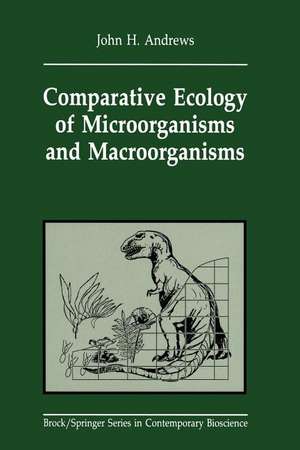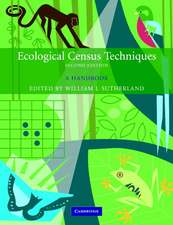Comparative Ecology of Microorganisms and Macroorganisms: Brock Springer Series in Contemporary Bioscience
Autor John H. Andrewsen Limba Engleză Paperback – 8 oct 2011
| Toate formatele și edițiile | Preț | Express |
|---|---|---|
| Paperback (2) | 587.39 lei 6-8 săpt. | |
| Springer – 12 mai 2018 | 587.39 lei 6-8 săpt. | |
| Springer – 8 oct 2011 | 641.71 lei 6-8 săpt. | |
| Hardback (1) | 593.73 lei 6-8 săpt. | |
| Springer – 27 iun 2017 | 593.73 lei 6-8 săpt. |
Preț: 641.71 lei
Preț vechi: 754.95 lei
-15% Nou
Puncte Express: 963
Preț estimativ în valută:
122.81€ • 133.35$ • 103.16£
122.81€ • 133.35$ • 103.16£
Carte tipărită la comandă
Livrare economică 23 aprilie-07 mai
Preluare comenzi: 021 569.72.76
Specificații
ISBN-13: 9781461277866
ISBN-10: 1461277868
Pagini: 324
Ilustrații: XVI, 302 p.
Dimensiuni: 155 x 235 x 17 mm
Greutate: 0.45 kg
Ediția:Softcover reprint of the original 1st ed. 1991
Editura: Springer
Colecția Springer
Seria Brock Springer Series in Contemporary Bioscience
Locul publicării:New York, NY, United States
ISBN-10: 1461277868
Pagini: 324
Ilustrații: XVI, 302 p.
Dimensiuni: 155 x 235 x 17 mm
Greutate: 0.45 kg
Ediția:Softcover reprint of the original 1st ed. 1991
Editura: Springer
Colecția Springer
Seria Brock Springer Series in Contemporary Bioscience
Locul publicării:New York, NY, United States
Public țintă
ResearchCuprins
1 Introduction: Prospects for a Conceptual Synthesis.- 1.1 Differences and Similarities.- 1.2 A Framework for Comparison.- 1.3 What is an Individual?.- 1.4 Summary.- 1.5 Suggested Additional Reading.- 2 Genetic Variation.- 2.1 Introduction.- 2.2 Mechanisms.- 2.3 Sex and Meiotic Recombination.- 2.4 Somatic Variation and the Concept of the Genet.- 2.5 Summary.- 2.6 Suggested Additional Reading.- 3 Nutritional Mode.- 3.1 Introduction.- 3.2 What is a Resource?.- 3.3 Some Fundamental Resource Categories and Their Implications.- 3.4 Resource Acquisition.- 3.5 Summary.- 3.6 Suggested Additional Reading.- 4 Size.- 4.1 Introduction.- 4.2 Constraints on Natural Selection: Phylogenetic, Ontogenetic, and Allometric.- 4.3 Why Are There Macroorganisms?.- 4.4 On Seeing the World As an Elephant or a Mycoplasma.- 4.5 Some Correlates of Size.- 4.6 Some Ecological Consequences of Size.- 4.7 Size and Life History Theory.- 4.8 Summary.- 4.9 Suggested Additional Reading.- 5 Growth and Growth Form.- 5.1 Introduction.- 5.2 Unitary and Modular Organisms: An Overview.- 5.3 Fungi As Modular Organisms.- 5.4 Bacteria As Modular Organisms.- 5.5 Some Implications of Being Modular.- 5.6 Some Implications to Modular Organisms of Being Sessile.- 5.7 Form in the Natural World.- 5.8 Summary.- 5.9 Suggested Additional Reading.- 6 The Life Cycle.- 6.1 Introduction.- 6.2 Simple Versus Complex Life Cycles.- 6.3 Senescence.- 6.4 Summary.- 6.5 Suggested Additional Reading.- 7 The Environment.- 7.1 Introduction.- 7.2 The Environment and Organism Are Coupled.- 7.3 How Organisms Experience Environments.- 7.4 How Organisms Respond to Environments.- 7.5 Traffic Lights Regulate Progress Through the Life Cycle.- 7.6 Habitable Sites and the Evolution of Gene Flow.- 7.7 Summary.- 7.8 Suggested Additional Reading.- 8 Conclusion: Commonalities and Differences in Life Histories.- 8.1 Levels of Comparison.- 8.2 On Being a Macroorganism or a Microorganism.- 8.3 Natural Selection As the Common Denominator.- 8.4 Microbial Ecology and Macroecology Are Complementary.- 8.5 Summary.
Notă biografică
John Andrews was born in Montreal, Canada and did his undergraduate education in agriculture at McGill University. He received graduate degrees from the University of Maine and the University of California, Davis, followed by postdoctoral work at Cambridge University and the University of British Columbia. He was recruited to the faculty at the University of Wisconsin-Madison, where he served for 35 years teaching and doing research in the areas of microbial ecology, plant pathology, and integrated pest management, among several others. He retired in 2010.
Textul de pe ultima copertă
This second edition textbook offers an expanded conceptual synthesis of microbial ecology with plant and animal ecology. Drawing on examples from the biology of microorganisms and macroorganisms, this textbook provides a much-needed interdisciplinary approach to ecology. The focus is the individual organism and comparisons are made along six axes: genetic variation, nutritional mode, size, growth, life cycle, and influence of the environment. When it was published in 1991, the first edition of Comparative Ecology of Microorganisms and Macroorganisms was unique in its attempt to clearly compare fundamental ecology across the gamut of size. The explosion of molecular biology and the application of its techniques to microbiology and organismal biology have particularly demonstrated the need for interdisciplinary understanding. This updated and expanded edition remains unique. It treats the same topics at greater depth and includes an exhaustive compilation of both the most recent relevant literature in microbial ecology and plant/animal ecology, as well as the early research papers that shaped the concepts and theories discussed. Among the completely updated topics in the book are phylogenetic systematics, search algorithms and optimal foraging theory, comparative metabolism, the origins of life and evolution of multicellularity, and the evolution of life cycles.
From Reviews of the First Edition:
"John Andrews has succeeded admirably in building a bridge that is accessible to all ecologists."
-Ecology
"I recommend this book to all ecologists. It is a thoughtful attempt to integrate ideas from, and develop common themes for, two fields of ecology that should not have become fragmented."
-American Scientist
"Such a synthesis is long past due, and it is shameful that ecologists (both bigand little) have been so parochial."
-The Quarterly Review of Biology
Caracteristici
Illustrates concepts and principles of ecological biology by referencing many forms of life Presents interdisciplinary analogies between the biology of microorganisms and macroorganisms Provides an expanded edition to include important ecological research over the past decade Includes supplementary material: sn.pub/extras


























